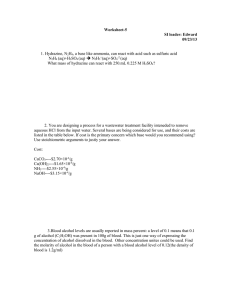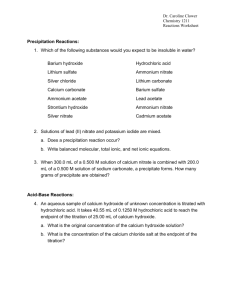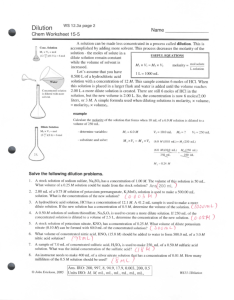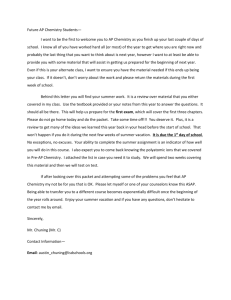File - HSFC Chemistry
advertisement
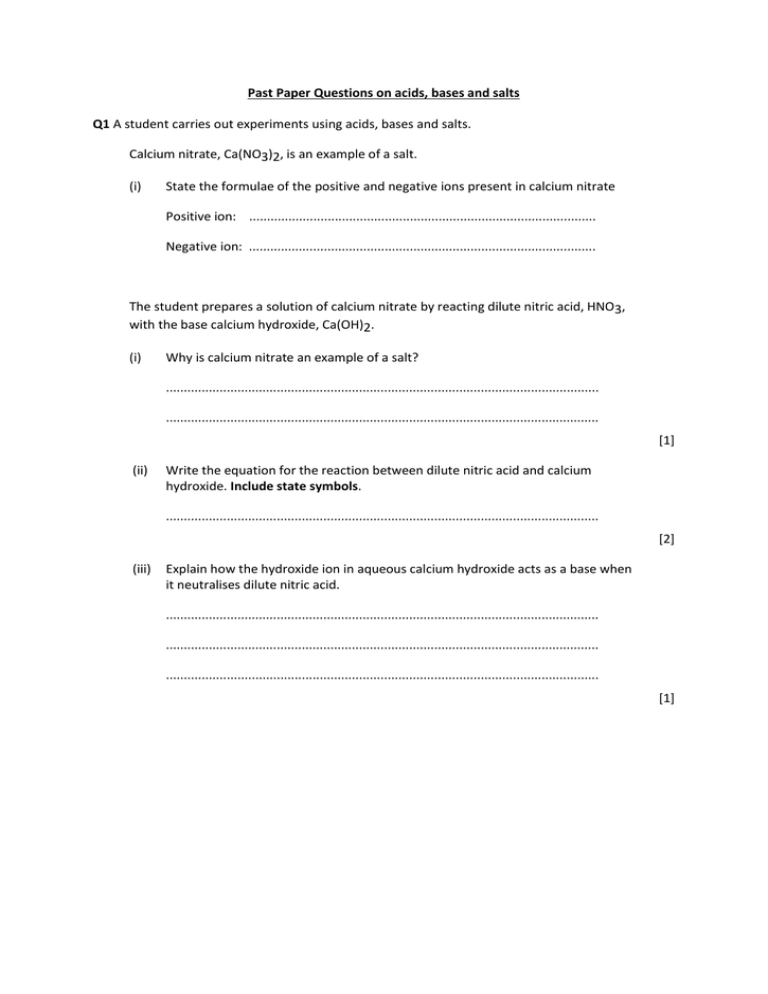
Past Paper Questions on acids, bases and salts Q1 A student carries out experiments using acids, bases and salts. Calcium nitrate, Ca(NO3)2, is an example of a salt. (i) State the formulae of the positive and negative ions present in calcium nitrate Positive ion: ................................................................................................. Negative ion: ................................................................................................. The student prepares a solution of calcium nitrate by reacting dilute nitric acid, HNO3, with the base calcium hydroxide, Ca(OH)2. (i) Why is calcium nitrate an example of a salt? ......................................................................................................................... ......................................................................................................................... [1] (ii) Write the equation for the reaction between dilute nitric acid and calcium hydroxide. Include state symbols. ......................................................................................................................... [2] (iii) Explain how the hydroxide ion in aqueous calcium hydroxide acts as a base when it neutralises dilute nitric acid. ......................................................................................................................... ......................................................................................................................... ......................................................................................................................... [1] Q2 After carrying out a titration a student left the resulting solution to crystallise. White crystals were formed, with a formula of Na2SO4•x H2O and a molar mass of 322.1 g mol–1. (i) What term is given to the ‘•x H2O’ part of the formula? ................................................................................................................ [1] (ii) Using the molar mass of the crystals, calculate the value of x. answer = ................................... [2] Q3 Epsom salts can be used as bath salts to help relieve aches and pains. Epsom salts are crystals of hydrated magnesium sulfate, MgSO4•xH2O. A sample of Epsom salts was heated to remove the water. 1.57 g of water was removed leaving behind 1.51 g of anhydrous MgSO4. (i) Calculate the amount, in mol, of anhydrous MgSO4 formed. amount = .................................................. mol [2] (ii) Calculate the amount, in mol, of H2O removed. amount = .................................................. mol [1] (iii) Calculate the value of x in MgSO4•xH2O. x = ........................................................ [1] [Total 4 marks] Q4 Ammonium compounds such as ammonium sulfate, (NH4 )2SO4, can be used as fertilisers. (i) Write a balanced equation to show how ammonium sulfate could be formed by the reaction between aqueous ammonia and sulfuric acid. .................................................................................................................................... [1] (ii) Ammonium sulfate is an example of a salt formed when an acid is neutralised by a base. Explain what is meant by the term salt. ........................................................................................................................................... ...........................................................................................................................................[1] (iii) Why is ammonia acting as a base in this neutralisation? ........................................................................................................................................... ...........................................................................................................................................[1] (iv) What is the relative formula mass of (NH4 )2SO4? Give your answer to one decimal place. ........................................................................................................................................... [1] Q5 Chemicals called ‘acids’ have been known throughout history. The word acid comes from the Latin ‘acidus’ meaning sour. Dilute sulfuric acid, H2SO4, is a common laboratory acid. (a) (i) State the formulae of two ions released when sulfuric acid is in aqueous solution. ...................................................................................................................................... [2] (ii) A student adds a sample of solid potassium carbonate, K2CO3, to an excess of dilute sulfuric acid. Describe what the student would see and write the equation for the reaction which takes place. ........................................................................................................................................... ........................................................................................................................................... ........................................................................................................................................... ........................................................................................................................................... ...........................................................................................................................................[3] Q6 Copper(II) nitrate is a salt of nitric acid. (i) A student prepares a solution of copper(II) nitrate, Cu(NO3)2, by adding, with stirring, an excess of copper(II) oxide to some hot dilute nitric acid. Construct the equation for this reaction. .................................................................................................................................... [2] Hydrated crystals of copper(II) nitrate can be prepared by allowing water to evaporate from a solution of copper(II) nitrate. Hydrated copper(II) nitrate has the empirical formula CuN2O12H12. Write the formula of hydrated copper(II) nitrate to show its water of crystallisation. ............................................................................................................................................ [1] Q7 Many metallic elements react with dilute hydrochloric acid to form a solution containing a salt. (a) Zinc reacts with dilute hydrochloric acid to form a solution of the salt, zinc chloride, ZnCl2. Zn(s) + 2HCl(aq) ZnCl2(aq) + H2(g) (i) Explain why ZnCl2 is a salt. ........................................................................................................................................... ........................................................................................................................................... ...........................................................................................................................................[1] (ii) Predict the formula of the zinc salt that could be formed by adding an excess of zinc to phosphoric(V) acid, H3PO4. .................................................................................................................................... [1] Q8 Anhydrous calcium chloride has the chemical formula CaCl2. Hydrated calcium chloride has a molar mass of 219.1 g mol–1. (i) What is meant by the term hydrated calcium chloride? ........................................................................................................................................... ........................................................................................................................................... ............................................................................................................................................[1] (ii) Determine the formula of the hydrated calcium chloride. You must show your working. formula = ......................................................... [2] Q9 Ammonia, NH3, and hydrazine, N2H4, are both bases. (a) Ammonium sulfate, (NH4)2SO4, can be prepared by reacting ammonia with sulfuric acid, H2SO4. (i) Why can ammonium sulfate be described as a salt? ........................................................................................................................................... ............................................................................................................................................[1] (ii) A student was given 400 cm3 of aqueous ammonia solution, NH3(aq). The student was asked to determine how many moles of NH3 had been dissolved to prepare the solution. The student titrated 25.0 cm3 of NH3(aq) and found that it reacted exactly with 32.5 cm3 of 0.100mol dm–3 sulfuric acid. The equation for this reaction is shown below. 2NH3(aq) + H2SO4(aq) (NH4)2SO4(aq) Calculate the amount, in moles, of NH3 in the original 400 cm3 solution. answer = .................................................. mol [3] Like ammonia, hydrazine is a base that reacts with water to form negative and positive ions. (i) Write the formula of the negative ion that is formed when hydrazine reacts with water. ...................................................................................................................................... [1] (ii) Suggest the formula of a positive ion which might form when hydrazine reacts with water. ...................................................................................................................................... [1] Some hydrazine reacts with NH2Cl to form ammonium chloride and a colourless gas with a relative molecular mass of 28.0. Construct the equation for this reaction. ...................................................................................................................................... [2]

